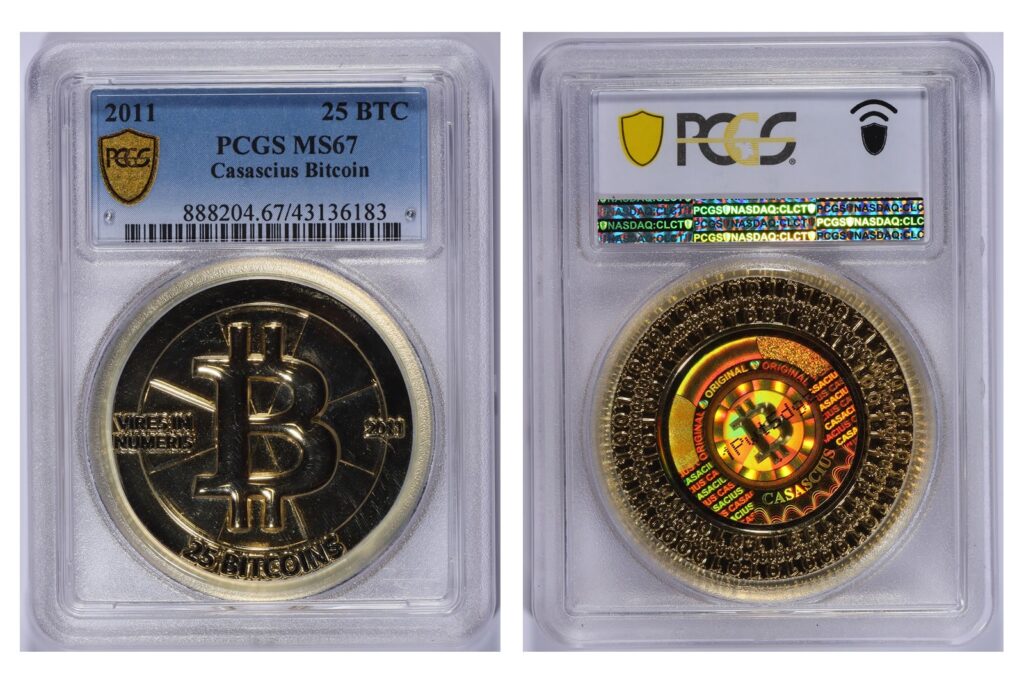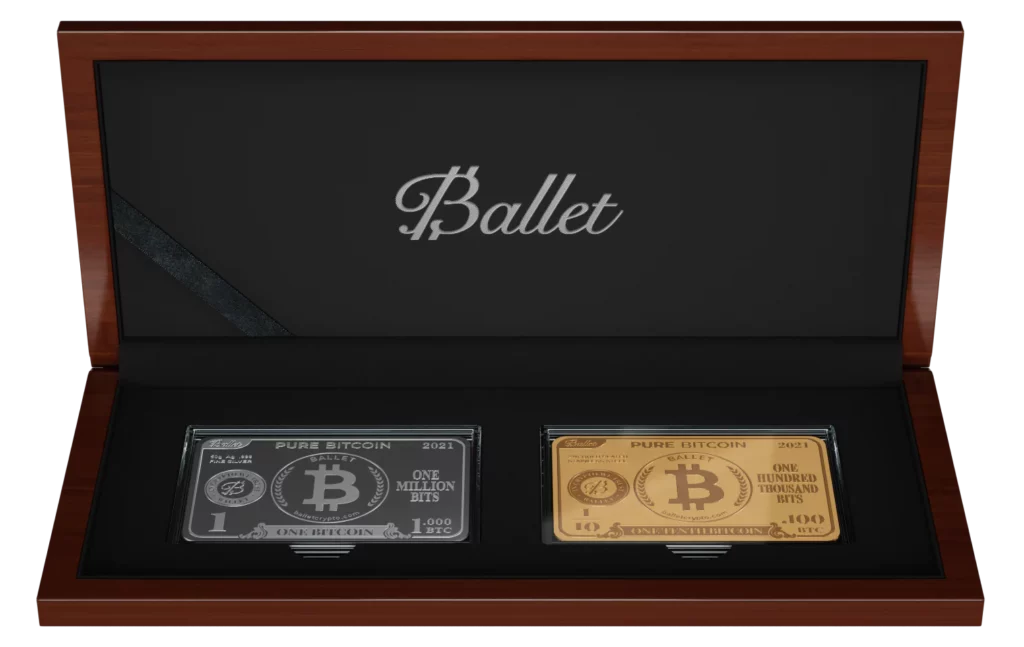What Is Physical Bitcoin? New Premier Guide 2024
Imagine a future where the intangible nature of Bitcoin merges with the tangibility of coins. What if you could pay for dinner or movie tickets with metal coins tied to the value of cryptocurrency, rather than using traditional cash? This isn’t just a fantasy. The concept of physical bitcoin is evolving continuously.
These tokens are designed specifically for those who value the tactile security of traditional assets, aiming to bridge the gap between the digital and physical realms. While they may resemble familiar currencies made of brass, silver, or gold, their true value lies beneath the surface.
Unlike traditional coins with fixed value, the value of physical bitcoins comes from the private keys printed on them. These keys are linked to digital wallets capable of holding any amount of BTC, from 1 BTC to 100 BTC.
In our digitally dominated era, where information and assets float in virtual clouds, there still exists a palpable craving for something tangible. Physical bitcoins cater to those cautious of purely digital assets, providing a practical way to understand the world of cryptocurrency. As the world evolves, these coins may just be the next step in completely altering how we perceive and handle money.
What Is Physical Bitcoin?
Physical bitcoin is tangible forms of bitcoin, typically presented in the form of metal or plastic coins. These coins often contain the public or private keys of bitcoins, or store the private keys through hidden storage mediums such as QR codes. The emergence of physical bitcoins aims to combine the value of cryptocurrency with tangible form, allowing people to understand and hold bitcoins more intuitively. They are often used as collectibles, gifts, or memorabilia, and can also serve as alternatives in actual transactions.
The term “physical bitcoin” might perplex those with only a basic understanding of cryptocurrency.
How can purely digital assets like Bitcoin become tangible? Doesn’t this contradict the fundamental principles of cryptocurrency? Why would anyone want physical bitcoins when the primary advantage of Bitcoin lies in its digital nature?
These are valid concerns. However, the answer lies in understanding that physical bitcoins do not possess intrinsic value. Instead, they serve as symbols of genuine bitcoins, reflected by the unique digital keys embedded in each tangible component, making them coveted items among some cryptocurrency enthusiasts.
For example, a physical bitcoin might resemble a gold coin engraved with the Bitcoin logo. On its back, there’s a unique digital code shielded by a holographic sticker. This code provides access to an actual Bitcoin wallet on the internet.
Essentially, with proper digital security measures, theoretically, any item could be converted into a representation of Bitcoin and linked to its digital counterpart.
How Is Physical Bitcoin Created?
Many people use 3D printers to create physical bitcoin. Since these are typically made by enthusiasts rather than any central authority, designs may vary greatly. Some coins have metallic coatings, while others are entirely made of silver or gold.
The true value of these coins lies not in their materials but in the private keys embedded on the back. This key allows its holder to claim the associated BTC online. Each token has its unique private key, ensuring that even if someone steals or tampers with the token, they can only access the BTC associated with that specific token. In contrast, if it were a digital wallet, a breach could expose all stored cryptocurrencies.
The First Physical Bitcoin
During the nascent stages of Bitcoin, before its breakthrough beyond the $1,000 mark, there was a fervor for casting tangible representations of this digital asset. These were not merely symbolic; besides serving promotional and collectible purposes, they had actual BTC value.
Mike Caldwell pioneered this movement by introducing Casascius coins in 2011. These coins not only had a decorative appeal but also an intrinsic value. They embedded genuine Bitcoin values, making them topics of discussion in the crypto world. By the end of 2013, Caldwell had successfully minted 27,000 such coins, ranging from brass denominations of 0.5 and 1 BTC to gold-plated 1,000 BTC bars.
However, ambitious ventures like Caldwell’s encountered regulatory hurdles when the Financial Crimes Enforcement Network (FinCEN) under the U.S. Department of the Treasury intervened. They found his operations akin to money transmitters, requiring federal registration to continue.

Following the Casascius Coin incident and FinCEN‘s interference, subsequent ventures into physical bitcoins treaded cautiously. For instance, the Argentine Mint opted for a lavish approach, producing luxurious commemorative coins with strong artistic appeal but lacking practical currency utility. These coins featured designs of Adam Smith and Saint Joan of Arc, but due to the rapid leak of the code, they faced challenges of their own.
Other early Bitcoin projects like Titan Bitcoin and Antana are remembered for their unique aesthetics and shameless marketing angles, incorporating imprints and jokes from Greek, Roman, and crypto cultures.
While the physical Bitcoin craze waned before the cryptocurrency boom of 2017, those with these historical relics may consider them priceless, especially considering Bitcoin’s rapid evolution.
Physical Bitcoin with Embedded BTC Value
There are some “physical Bitcoin” products, typically metal coins, with all the information needed to access BTC coins on the Bitcoin blockchain. This information is usually hidden in a tamper-evident way. Physical bitcoins are sold in various denominations, representing different amounts of Bitcoin.
Early on, several companies produced physical bitcoins, but the trend has waned recently. The most famous physical bitcoin product was produced by a company called Casascius.
Casascius Bitcoin have a private key imprinted on the coin, hidden by holography. If someone tries to tamper with the pattern, it turns into a honeycomb pattern. On the outside of the coin, you can see the first 8 characters of the Bitcoin address associated with that coin.
During Casascius’ time in business, the company produced different versions of these coins, denominating 0.1 BTC, 0.5 BTC, 1 BTC, 10 BTC, 25 BTC, 100 BTC, and 1,000 BTC. Casascius was established in 2011 when Bitcoin’s value was much lower than it is today. At current prices, 1,000 BTC is equivalent to $37.8 million.
Unfortunately, for fans of physical BTC, Casascius decided to shut down shop after U.S. regulatory agency FinCEN told the company they needed a money transmitter license if they wanted to continue operating.
Other companies that have made physical Bitcoin coins include Ravenbit, Titan Bitcoin, and Alitin Mint.
Today, users can purchase physical bitcoin (though in card form, not coin form) from a company called Ballet. These cards are called “REAL Bitcoin,” and denominations range from 0.1 BTC to 0.005 BTC.

While such products have a certain aesthetic appeal, they are quite cumbersome to use and do not offer any real benefits compared to using hardware cryptocurrency wallets alone.
In fact, physical bitcoin with embedded BTC value are not as secure as using hardware cryptocurrency wallets, since the BTC value contained in them can be easily accessed by thieves.
Meanwhile, a thief stealing your hardware wallet would need to guess your PIN and then access your tokens, giving you time to recover your wallet using a mnemonic and send your tokens to another wallet under your control.
Additionally, you must trust that the manufacturer of physical bitcoin cannot actually access the private keys imprinted on the coins. This isn’t an issue for hardware cryptocurrency wallets since they generate keys offline.
Decorative Physical Bitcoin
Most of the “physical bitcoin” you see online are actually decorative. These representations of bitcoins can be used as props in photos and videos or as home decor.
Most often, these decorative physical bitcoins are made of golden-colored metal and prominently feature the Bitcoin project’s logo. They usually have some text engraved around the edges of the coin.
How Much Are the Coins Worth?
The value of physical bitcoins initially seems directly related to the amount of BTC embedded in their private keys. However, the reality is more nuanced. Typically, due to their scarcity, the selling price of these tokens exceeds the value of the BTC they protect.
The composition material of the coins significantly affects their valuation. As emphasized, these tokens can be made of various materials, from gold-plated varieties to gold, silver, and even plastic. Naturally, gold coins fetch higher prices compared to simple gold-plated ones.
Another critical dimension is collectability. Given their unique materials, designs, and limited numbers, some coins have become items for collectors. An older minted coin, especially if it’s a limited edition, may command a value higher than the Bitcoin it holds. Its rarity may elevate it to a status akin to vintage movie posters or discontinued fiat currency, desirable not just for the embedded bitcoins but also as collectibles themselves.
Legality
Owning physical bitcoin is generally legal, provided your jurisdiction permits the possession of cryptocurrencies. On the other hand, creating such tangible tokens might violate specific financial transmission regulations. In such cases, there may be an obligation to register with the appropriate regulatory authorities.
Besides their tangibility, verifying the authenticity of physical bitcoin is crucial, as there may be counterfeits. Genuine physical bitcoins usually come with private keys or QR codes, linking them to a certain amount of bitcoins. Ensuring this linkage and the credibility of the issuer helps determine their authenticity.
Advantages and Disadvantages
The appeal of physical bitcoins is evident to those who have witnessed the ebbs and flows of the cryptocurrency tide over the past decade. Essentially, physical bitcoins offer a tangible presence to something typically seen as purely virtual digits.
Moreover, the physical versions further diversify an asset already renowned for its decentralized nature. They enable people to achieve Bitcoin storage diversification across multiple “locations,” encompassing both tangible and intangible realms, thereby enhancing the security of your holdings.
There’s also an undeniable aesthetic allure. While physically different, physical bitcoins typically exude a sense of solidity, elegant design, and intricate engraving, catching the attention of cryptocurrency enthusiasts.
However, these tangible versions somewhat contradict the core principles of cryptocurrency to some extent: digital currencies promise to render jingling coins and leather wallets obsolete.
While some prefer diversifying their Bitcoin holdings, others are hesitant, fearing the potential risks of physical encrypted storage. Many of the early minted physical bitcoins faced security vulnerabilities once their codes were exposed.
Apart from the challenges, legal hurdles continue to cast a shadow over the creation and use of physical bitcoins, ultimately leading to a decline in their popularity.
Physical Bitcoin ETFs
Another instance where you might hear the term “physical bitcoins” is in the context of physical Bitcoin ETFs (Exchange-Traded Funds). These ETFs are backed by BTC tokens held by the ETF issuer. The use of the term “physical” here is somewhat confusing, as the BTC held by physical Bitcoin ETFs is still entirely digital.
One example of such products is the Fidelity Physical Bitcoin ETP (FBTC), which trades on European stock exchanges. Currently, such products are not available for sale in the United States. Physical Bitcoin ETFs are typically contrasted with futures-based Bitcoin ETFs, which don’t hold any BTC but rather hold Bitcoin futures contracts.
Bottom Line
The value of physical bitcoin primarily lies in their tangible form, collectible value, symbolic significance, and, in some cases, their utility as alternative tools in actual transactions.
Physical bitcoins are intriguing novelties but little more than that. As a form of cold storage, they are not as convenient and secure as combining the use of hardware cryptocurrency wallets with metal cryptocurrency wallet backups.